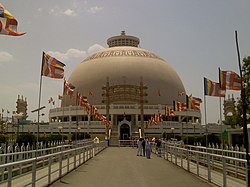
The Twenty-two vows or twenty-two pledges are the 22 Buddhist vows administered by Dr. B. R. Ambedkar , the revivalist of Buddhism in India, to his followers. On converting to Buddhism, Ambedkar made 22 vows, and asked his 400,000 supporters to do the same. [1] After receiving lay ordination, Ambedkar gave dhamma diksha to his followers. This ceremony organised on 14 October 1956 in Nagpur included 22 vows administered to all new converts after Three Jewels and Five Precepts. On 16 October 1956, Ambedkar performed another mass religious conversion ceremony at Chandrapur. [2]
Contents
It is believed by Ambedkarite Buddhists that these vows are the guidelines of the social revolution that motivates human instincts. These vows demonstrate both the social movement aspect of Navayana Buddhism, and demonstrate its core deviation from earlier sects of Buddhism. In India, these vows are taken as an oath by individuals or groups of people when they convert to Buddhism. [3] [4]


